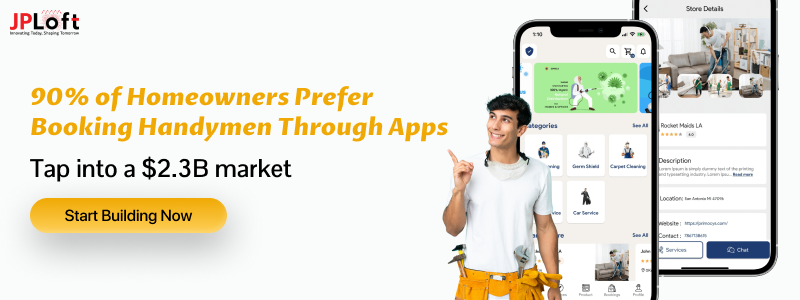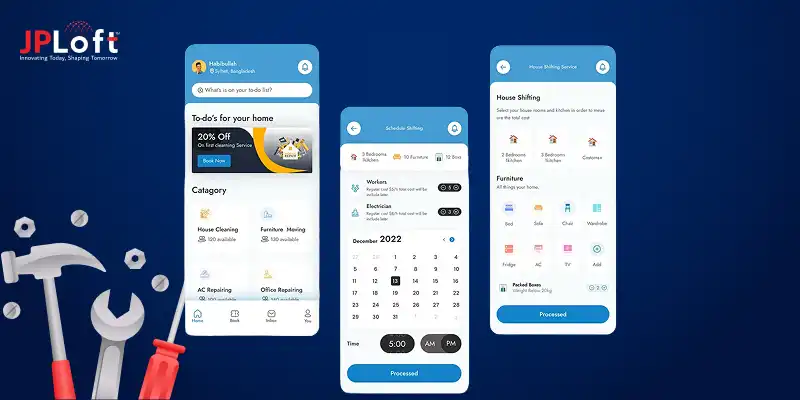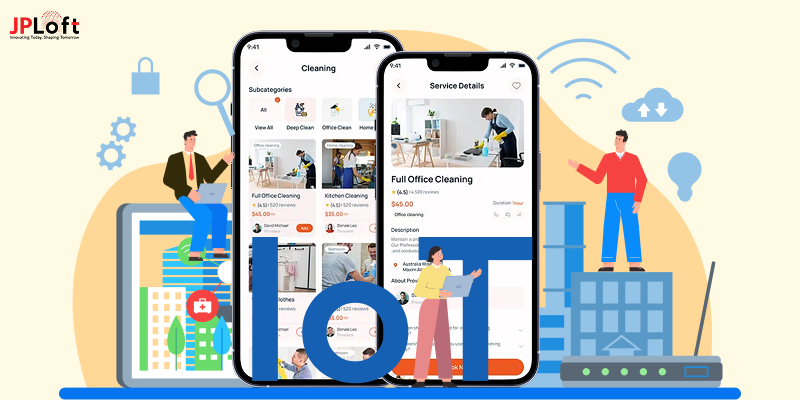Key Takeaways:
The process to develop a robust and scalable app like Porch involves market research, defining features, designing UI/UX, choosing a tech stack, testing thoroughly, and launching with scalability in mind.
A two-sided marketplace model solves the problem of fragmented services by directly connecting homeowners with verified professionals.
Subscription-based models in handyman apps ensure consistent revenue while providing recurring value for customers.
Adding AI features like smart job matching and predictive maintenance increases efficiency, user trust, and long-term retention.
Entrepreneurs should focus on scalable architecture to handle real-time bookings, payments, and integrations without performance issues.
Partnering with an experienced company like JPLoft will help you to reduce risks, accelerate time to market, and ensure compliance across regions.
The handyman industry is witnessing rapid digital transformation, and platforms like Porch have proven how technology can unlock massive business opportunities.
For entrepreneurs, the key question is: how to develop an app like Porch?
The answer to build a custom app similar to Porch lies in blending on-demand booking, secure payments, AI-driven personalization, and a scalable business model that attracts both users and service providers.
“The simple joy of having a problem solved quickly is what keeps people coming back.” — Maya Angelou
This insight mirrors why apps like Porch succeed is they remove friction, build trust, and deliver value instantly.
For entrepreneurs and investors, this represents more than a convenience app; it’s a chance to capture a fast-growing market with recurring revenue streams and strong scalability.
In this complete guide, we’ll cover everything you need, including concept, business model, features, AI, costs, and challenges, to help you confidently plan and launch your own successful handyman platform.
Are you ready to begin? Yes! Then let's proceed.
An Overview of Porch: A Convenient Way to Manage Home
Porch is a handyman app that offers instant handyman bookings, with smart home management tools, and trusted pros, with upfront pricing and satisfaction guarantees, within a single app.
Let’s figure out its purpose, concept, and more below.
A] Concept Behind Porch
The Porch app is designed to make homeownership easier. Its primary function is to provide homeowners with one trusted platform where they can book reliable handymen instantly for tasks such as TV mounting, faucet replacement, or light switch repair.
At its essence, Porch is not merely a handyman app; it's an entire home maintenance toolbox. The idea is to walk homeowners through their homeownership lifecycle—from moving in day one, to annual upkeep, to major renovations. That's why it features things such as:
-
Integration with inspection reports to automatically generate to-do lists.
-
Appliance tracking with recall notifications.
-
Moving services with checklists and booking capabilities.
-
Concierge assistance for live assistance with selecting services.
This "all-in-one home hub" idea differentiates Porch from apps that specialize in booking gigs.
Well, when you proceed to create a handyman app, you should know the kind of business model it follows; hence, let’s proceed.
B] Business Model of Porch
Porch has a two-sided marketplace business model, which brings homeowners together with verified service professionals while generating revenue from:
-
Lead Generation Fees: Billing pros for connecting with homeowners.
-
Subscription Plans for Pros: Providing enhanced tools, top-rated listings, and business support administration.
-
Job Commissions: A percentage of the transaction when services are booked via Porch.
- Partnerships: Retailer, insurance, and moving company partnerships bring additional revenue streams and increase customer value.
This model generates consistent growth while establishing a win-win value for both homeowners and professionals.
C] Why Is Porch so Popular?
Porch has established a leading position in the handyman and home services business due to:
-
Trust and Safety: Every pro is background-checked, licensed, and supported by Porch's Satisfaction Promise and Property Protection.
-
Convenience: Homeowners get instant booking with upfront pricing and a one-stop shop for handyman, moving, and insurance needs.
-
Scalability: Porch’s broad service network makes it capable of handling everything from minor repairs to major projects.
-
Partnership Network: Deals with Lowe’s, Wayfair, and Realtor.com to expand its reach and credibility.
-
User-Centric Add-Ons: Features like concierge support and recall alerts improve everyday usefulness and keep customers loyal.
Well, after learning about concepts, let’s figure out the core reasons for building an app like Porch in the following section.
Reasons to Create an App like Porch
When you start an online handyman business, it is important to know the answer to the question “why”. Whether it's about developing an app like Porch or any other, identifying the purpose for your business is important.
Hence, let’s find it out below.
1. Growth in the Handyman Market
As per the handyman market statistics, in the year 2025, the global handyman market is estimated to be valued at approximately USD 530.5 million. Additionally, by the year 2035, it is expected to grow to around USD 2,340.4 million, reflecting a complete compound growth of 16%.
Thus, this is the right time to contribute to this growth and build your dream app. Along with this, the demand surge represents a great opportunity for you.
2. Increasing Adoption of On-Demand Apps
In this diversified market, the growth of on-demand apps surges. Here, the online app demand market size is valued at USD 5.15 billion in 2024. Further, it is estimated to grow from USD 5.97 billion in 2025 and is expected to reach USD 19.65 billion by 2033, at a CAGR of 16.04%.
Therefore, the trend to connect with a leading on-demand app development service is increasing, as building a porch-like app can position you right in the middle of this fast-growing world.
3. A shift towards Tech-Driven Solutions
With the growing trend of AI in mobile apps, consumers expect an AI-powered job matching, instant scheduling, with real-time updates, along with smart-home integrations.
Additionally, thoroughly leveraging automation and IoT, a porch-like app can further deliver highly personalized solutions to the users. Hence, when you create your own app like Porch, considering the personalized conditions, you can win the target audience.
4. Subscription-based and Recurring Models
You can switch to the subscription-based maintenance plans that might be either monthly or quarterly. This will ensure a consistent revenue for the businesses along with long-term convenience for the customers, which is an attractive model for the investors.
Hence, building an app like Porch can be an effective parameter that will be suitable for you to convert the normal business model to a subscription-based platform. It creates an opportunity for you to connect with the target audience gracefully.
5. Proven Success and Scalability of the Porch Model
The Porch currently has 10,000+ downloads on Google Play, with about 400 downloads in the past 30 days.
Hence, creating an app like Porch will help you to stand out in this diversified market. It can assist you in enhancing your presence by adopting current trends.
Are these reasons enough for you to initiate building an app like Porch?
Yes! Then let’s move ahead with the steps on how an app like Porch works, in the following section.
How Does an App like Porch Work?
If you want to convert your handyman app idea into a success, then identifying how an app works is a prime key.
Let’s learn about the key steps below.
Step 1: Onboarding of the User
The homeowners register with their name, address, and contact information. Even some apps auto-import home inspection reports to establish a digital record of the property. This lays the groundwork for tailored suggestions and quicker booking.
Step 2: Service Selection
Customers are able to browse through a list of jobs such as plumbing, electrical repair, appliance installation, or painting. Transparent service types with advanced pricing eliminate uncertainty and enable customers to be sure of what they are getting. It is easy to book and transparent.
Step 3: Professional Matching
The platform provides automated matching of homeowners with background-screened pros within their locality. Sophisticated apps employ AI or intelligent filters to match by ratings, availability, and specialization, providing both speed and quality of service delivery.
Step 4: Booking & Scheduling
Once a professional is selected, users authorize the service request and select a desired date and time. Integrated scheduling capabilities manage reminders, calendar syncing, and rescheduling options, thereby making the process flexible and hassle-free.
Step 5: Job Completion & Payment
The handyman comes, does the job, and marks the job status on the app. Payment is securely made through integrated gateways, while the platform's satisfaction guarantee or property protection instills confidence for both parties.
Step 6: Feedback & Engagement
After the work is completed, the customers rate and review to allow the next users to make informed decisions. Then the application goes out of its way to interact with them through upkeep advice, holiday promotions, or subscription plans to bring repeat visits and continued loyalty.
Now, let’s get ahead with the diversified types of features to include in an app like Porch in the following section.
Features to Include in an App like Porch
Features as the blood of an app, and when you ignore them, this can fail.
Thus, selecting the appropriate handyman app features is key. Let’s get to evolving them all below.
|
Feature |
Description |
|
On-Demand Handyman Booking |
Users can instantly hire vetted professionals for small fixes or big projects with upfront pricing. |
|
Smart To-Do Lists |
Auto-generate repair or maintenance tasks from inspection reports or let users create custom lists. |
|
Appliance Tracking & Alerts |
Track home appliances and receive notifications about recalls or required maintenance. |
|
Integrated Scheduling |
Easy booking with flexible time slots, reminders, and calendar sync for both users and pros. |
|
Secure In-App Payments |
Safe, fast, and transparent payment processing with receipts and guarantees built in. |
|
Ratings & Reviews |
Customers rate service providers, helping build trust and improve future matching. |
|
Pro Dashboard (for Service Providers) |
Tools for professionals to manage leads, schedules, payments, and customer communication. |
|
Home Concierge Support |
Live assistance to guide homeowners with bookings, offers, or finding the right pro. |
|
Partnership Integrations |
Add-ons like moving services, insurance comparison, and utility setup for extra value. |
With the learning of features, now it's time to look for “ building a Porch clone” in the section below.
Steps to Develop an App like Porch
When you step into building a popular app like Porch, it becomes your prime responsibility to focus on the development steps.
These are the keys to success, and they do help to avoid handyman app failures.
Hence, the question that arises is “How to develop an app like Porch?”
It starts from market study, identifying the core features, designing the app, selecting the best tech stack, to launching the app on the suitable platform.
Let’s learn these steps to build an app like Porch in detail, here.
Step 1: Perform a Complete Market Study
It does not only comprise a market study. The prime step here is to learn about the audience behavior, complete information related to competitors, and much more. Here’s a detail:
A] Audience Demographics and Preferences
Here, you need to define who the actual users are and their age groups, educational backgrounds, and how well they can understand, as well as get familiar with the app’s functionality.
B] Investigate User Behavior
It is important to investigate the current user behavior. Evaluate how the audiences can interact with gaming platforms, session durations, as well as preferred game formats.
C] Access the Overall Market Demand
You should evaluate the current market demand and the requirements to interact with the educational gaming platforms, preferred game formats, and session durations.
D] Learn About Competitors
Afterward, it is important to examine the existing platforms related to handymen. Here, you should conduct market research by using online searches and industry reports to evaluate what’s currently happening in the market.
Step 2: Select the Features
It is important to select the features for your app, like Porch. These features should be as per the purpose of building the app. Here’s a detail on the features.
A] Core Functionality Features
The core functionality features are the must-have features, such as push notifications, a booking system, a secure payment gateway, a service listing, appointment scheduling, and reviews.
B] Administrative Features
These features comprise a centralized dashboard for managing users, service providers, coupon management, performance analytics, and customer support tools.
C] Engaging Features
The engaging features for the handyman platform consist of real-time job tracking, secure in-app payment options, appointment scheduling, in-app chat, and multilingual support.
D] Advanced Features
Here, the advanced features should be real-time GPS tracking, dynamic pricing based on demand, and in-app chat, as well as a robust loyalty program.
Step 3: Design Your App
Now, it's time for a handyman app design. This is all about selecting the prominent design elements such as color, theme, typography, and more. Let’s learn it completely, below.
A] User Interface (UI) Design
Creating intuitive layouts, color schemes, typography, and visual hierarchy for optimal user experience. Here, the responsibility lies with the designers to make the first impression of the app solid among the users.
B] User Experience (UX) Flow and Navigation
Mapping user journeys, designing seamless navigation paths, and ensuring logical flow between features. Here, you should evaluate the user behavior and then implement user-friendly features accordingly.
C] Wireframing and Prototyping
Furthermore, you should create a mobile app wireframe, which is all about creating the framework for the app. Additionally, it's about developing interactive app prototypes to validate design concepts before development.
D] Responsive Design and Accessibility Standards
Here, the mobile app design should be focused on adapting a website’s layout, images, and text to different sizes. Ensuring cross-device compatibility and implementing accessibility features for inclusive user access.
Step 4: Select a Suitable Technology Stack
Have you selected a suitable handyman app tech stack for your app? Well, if not, then this is the time to build it.
A] Selection of Frontend Technology
Selecting the relevant technology also comprises evaluating the frontend technology, such as React, Vue.js, and Angular, for the web. The react native or Flutter for mobile app development.
B] Backend Infrastructure and Database Choice
Here, you should select the server technologies (Node.js, Python, Java) and databases (MongoDB, PostgreSQL, MySQL) based on the scalability needs. The backend infrastructure comprises core components for handling data, logic, and communication for an app’s server-side.
C] Cloud Services and Hosting Platforms
Here, you need to evaluate AWS, Google Cloud, or Azure for hosting, storage, as well as the deployment requirements. You need to include the cloud platform and select the best fit as per your needs, which can be Amazon Web Services or Google Cloud.
D] Third-Party Integrations and APIs
Identifying necessary external services for payments, analytics, authentication, and educational content management. Here, the APIs that can be included for porch-like app development can be the Google Maps API, the Payment gateway APIs, the Communication APIs, and the analytical APIs.
Step 5: Complete Testing
Now, it's time to go for mobile app testing. This is one of the particular determinants that will be helpful for optimizing the overall performance of the app.
A] Functional Testing and Feature Validation
Functional testing of all app features, user flows, and essential functionalities to verify that they behave as expected. Test edge scenarios such as network disconnection, concurrent user actions, and multiple content types to validate strong handyman app performance.
B] Performance and Load Testing
With the handyman app testing framework, you can evaluate app speed, responsiveness, and ability to handle multiple concurrent users during peak usage. Simulate scenarios with hundreds or thousands of simultaneous participants to identify bottlenecks and optimization opportunities.
C] Security and Data Protection Testing
Implementing vulnerability tests, penetration testing, and adherence to data privacy laws. Testing for handyman app security vulnerabilities such as SQL injection, cross-site scripting, and lack of authorization and data access. Ensuring that user data, particularly student data, is encrypted and safeguarded as per education privacy protocols such as COPPA and FERPA.
D] User Acceptance Testing (UAT)
Collecting feedback from actual users, teachers, and the target group to confirm usability and effectiveness. Organize testing sessions involving actual teachers and students to see the actual behavior while using the platform. Gather feedback on the clarity of the interface, usefulness of features, and satisfaction overall to pinpoint areas for tweaking before launch.
Step 6: Launch the MVP
You should proceed with the MVP launch, which is all about launching with the basic features and then improving them further.
A] Production and Deployment Setup
Setting up production environments, installing monitoring systems, and having a stable server infrastructure. When you develop an app like Porch, put in place automated deployment pipelines, error logs, and performance monitoring to keep service availability consistent for both homeowners and service providers.
B] Launch and Marketing Strategy
Creating promotional initiatives, contacting homeowners and service providers, and making target markets aware. Develop marketing content emphasizing the value proposition of your app versus current options, such as Porch.
C] App Store Submission and Approval
Crafting app store listings, descriptions, screenshots, and handling the approval process for iOS and Android platforms. Optimize your app store presence with engaging descriptions of seamless service booking, verified professionals, and trusted home maintenance solutions.
D] Initial User Onboarding and Support
Developing tutorial content, support documentation, and building customer support channels for initial users. Design step-by-step instructions for homeowners scheduling services and contractors handling their profiles and service requests.
Step 7: Add Feedback and Maintain the App
In this last but not least step, you should include the feedback in the app to make it more user-centric. This is all about identifying what the users meant by a porch-like app and what they further want in it.
A] User Feedback Collection and Analysis
With the handyman app maintenance, you can enact feedback mechanisms, questionnaires, and analytics software to collect user feedback and usage habits from homeowners and service professionals.
B] Bug Fixes and Performance Optimization
Ongoing monitoring for problems, fixing technical issues, and optimizing app performance based on user data when building an app like Porch requires reliable mobile app maintenance services. Regularly monitor performance metrics and optimize code, database queries, and server settings to ensure quick response times during high-booking seasons.
C] Feature Additions and Enhancement Releases
Designing and rolling out new features, enhancing current functionality based on user demands and industry trends in the home services market. Create a feature addition roadmap that makes the service booking process better, contractor-homeowner communication more efficient, and payment processes smoother.
D] Long-term System Maintenance and Platform Upgrades
Handling regular server maintenance, security updates, and compatibility with new operating system releases. Scale your improvements as your user population increases and comply with changing regulations in the home services and gig economy sectors.
These were some of the important steps to consider when it comes to building an app like Porch. Now, the question is, as per the recent handyman app trends, can there be a simpler and technology-driven way to make a Porch clone?
Well, yes, the implementation of AI is one of them. Let’s consider the following section for more details.
Can AI be Helpful to Build an App like Porch?
Yes, as per the latest technology trend in the market, it is a helpful technology; hence, you can connect with the leading AI app development company if you want to include artificial intelligence.
Well, AI in handyman apps can help you improve the app’s performance through increasing personalization, and
► Intelligent Job Matching
AI can match users with the most appropriate handyman based on user request, location, and pro skill sets automatically. It minimizes wait times and enhances satisfaction.
It assists pros too by showing them only suitable jobs, saving time and boosting conversion rates.
► Dynamic Pricing & Cost Estimating
By doing so, AI can provide immediate cost quotes for services such as faucet fix or furniture assembly. Dynamic pricing promotes transparency and trust.
It also enables the platform to dynamically charge according to demand, availability, and urgency, assuring optimal value for the customer as well as the provider.
► Predictive Maintenance & Reminders
AI can anticipate when some home appliances or systems may require maintenance. For instance, sending reminders for HVAC maintenance or even flagging appliance recalls ahead of time.
This forward-looking strategy reduces expensive breakdowns and aligns the app as a valued long-term home maintenance companion.
► Fraud Detection & Safety
AI-powered verification technologies can authenticate service providers' IDs and licenses and even spot suspicious activity. This enhances homeowners' safety and preserves the app's reputation.
Besides, AI can track payments and user actions to avoid fraud, scams, or abuse on the platform. AI in cybersecurity does help in advanced detection of threats, predictive threat intelligence, and is effective in enhancing compliance and governance.
► Personalized User Experience
AI can make user behavior-driven suggestions, such as proposing seasonal activities (gutter cleaning during autumn, AC maintenance in summer).
This makes users active and loyal. By making every notification, offer, and reminder personal, AI makes each user believe that the app "knows" their requirements, increasing repeat usage.
Now, as you are ready to develop an app like Porch, let’s proceed with elaborating its cost in the following section.
What’s the Cost to Develop an App like Porch?
Building an app like Porch generally begins at $15,000 for a simple MVP with main features like service booking and messaging.
Once you include advanced features such as inspection uploads, concierge support, payment integrations, and service provider dashboards, the cost can range up to $100,000 or more. The price can increase if you want to include the updated trends in the app, such as artificial intelligence.
The ultimate price is very much influenced by design quality, backend complexity, and whether you are building for one platform (iOS or Android) or both. The given table provides an overall list of factors impacting the complete cost to build a handyman app.
|
Factor |
Estimated Cost Range |
Description |
|
UI/UX Design |
$3,000 – $8,000 |
Covers user flow design, wireframes, interface design, and prototype refinement. |
|
Front-end & Back-end Development |
$10,000 – $40,000 |
Main app architecture, user accounts, screens, and server-side logic. |
|
API & Third-Party Integrations |
$5,000 – $15,000 |
Payment gateways, maps, and external service integrations like insurance or inspections. |
|
Platform Choice (iOS/Android/Both) |
Add up to 2× base cost |
Building for both platforms separately doubles the cost; cross-platform frameworks can reduce it. |
|
Backend Infrastructure & Scaling |
$10,000 – $50,000+ |
Varies with complexity—basic backend or cloud-based scalable systems with real-time features. |
|
Quality Assurance & Testing |
10–20% of app cost |
Ensures smooth functionality, bug-free performance, and compatibility across devices. |
Till now, we have discussed the concept, reasons, features, steps to create an app like Porch, the role of AI, along the cost determinants.
Now, let’s identify how you can make money with the same.
How Can an App like Porch Earn Money?
Yes, you heard it right, you can earn money, developing an app like Porch. All you need is to opt for the right handyman business model, and then you can open multiple revenue streams.
Let’s figure out the complete monetization scope, below.
1] Lead Generation Fees
Pros pay a fee to get access to potential customers. This provides a consistent revenue stream while offering pro exposure to targeted, high-quality leads.
2] Job Commissions
Each booking completed earns the platform a small commission. This pay-per-job structure grows naturally as more users and pros get on board the app.
3] Subscription Plans for Pros
Experts pay extra for enhanced visibility, more sophisticated tools, and increased lead priority. This mobile app monetization strategy provides consistent, recurring revenue to the platform.
4] Integrations and Partnerships
Handyman API integration in apps like Porch allows seamless collaboration with retailers, insurance providers, and moving companies. These strategic partnerships not only create additional revenue streams but also enhance overall user value by offering bundled, convenient services.
5] In-App Promotions
Service providers may be paid for listed features or prioritized placement in search results. This advertising model supports professionals' growth while introducing a secondary layer of income.
Now, let’s proceed with the number of challenges to overcome when it comes to creating an app like Porch in the following section.
Challenges to Overcome to Make an App like Porch
What are the key challenges to building a handyman app?
Whether it's about building an app like Porch or any other. Considering the challenges can be effective in avoiding and overcoming any kind of consequences that might arise.
Challenges will make you aware of the silly errors that you can avoid and save time and resources for building an app like Porch.
Hence, let’s proceed to learn the challenges below.
1. Building Trust and Safety
When you try to create a Porch clone, trust becomes the biggest hurdle. Homeowners need assurance that the pros entering their homes are vetted, licensed, and background-checked. Without strict verification, it’s difficult to scale or gain repeat users.
2. Balancing Supply and Demand
If you want to build an app like Porch, you must carefully balance the number of service providers with customer demand. Too few pros cause delays, while too few requests discourage pros from staying active. Achieving this balance is key to retention.
3. Handling Service Quality Consistency
To make an app like Porch, you’ll face the challenge of ensuring consistent service quality across thousands of professionals. Since handyman work varies by skill and tools, a strong review system and accountability measures are needed to maintain standards.
4. Managing Complex Pricing Models
One major challenge when you develop a Porch clone is designing a transparent yet flexible pricing system. Different jobs vary in cost and time, and regional demand or surges can complicate consistency without smart pricing strategies.
5. Technical Scalability and Integrations
If you plan to build a Porch clone, your platform must handle real-time bookings, payments, and third-party integrations at scale. Without robust infrastructure, apps risk crashes, downtime, or poor user experiences that drive users away.
6. Navigating Legal and Regulatory Issues
To successfully make an app like Porch, compliance with labor laws, licensing, and insurance requirements in each region is essential. Overlooking regulations can lead to fines or reputational damage, slowing down growth in key markets.
Partner with JPLoft, and Create your Own App
If you’re planning to step into the booming home services industry, the smartest move is to partner with JPLoft and turn your vision into reality.
As a leading handyman app development company, JPLoft understands the unique challenges of building apps like Porch, from balancing supply and demand to integrating secure payments and real-time booking features. Our team goes beyond just coding; we design solutions that focus on user trust, scalability, and long-term growth.
With years of expertise and a proven track record, we help startups, enterprises, and entrepreneurs create powerful on-demand platforms tailored to their needs.
Whether it’s an MVP for quick market entry or a fully loaded app with advanced features like AI-powered matching and subscription models, we’ve got you covered. When you partner with us, you’re not just hiring developers, you’re working with a team committed to your success.
Conclusion
Creating an app like Porch requires more than just technical execution; it’s about combining convenience, trust, and innovation in one platform.
From offering instant handyman bookings to building a complete home management ecosystem, Porch shows how powerful this model can be. With the handyman market growing rapidly and on-demand services becoming the norm, now is the perfect time to turn your idea into reality.
By focusing on core features, scalability, and user experience, you can build a solution that stands out. Partnering with experts ensures you launch strong and grow confidently in this competitive industry.
FAQs
Start with market research, define core features, design UI/UX, choose a tech stack, build the MVP, test thoroughly, and launch with scalability in mind.
Users onboard, select a service, get matched with vetted pros, schedule jobs, pay securely, and leave reviews. The app manages reminders, guarantees, and feedback loops.
Instant handyman booking, secure payments, ratings and reviews, scheduling tools, pro dashboards, appliance tracking, and concierge or partner integrations for insurance and moving services.
Revenue comes from lead generation fees, commissions on jobs, subscription plans for pros, and partnerships with retailers, insurance providers, or moving companies.
Development ranges from about $15,000 for a basic MVP to over $100,000 for a fully featured platform with AI, integrations, and advanced scalability.
Yes, AI enables smarter job matching, dynamic pricing, predictive maintenance reminders, fraud detection, and personalized recommendations to boost engagement and retention.













Share this blog